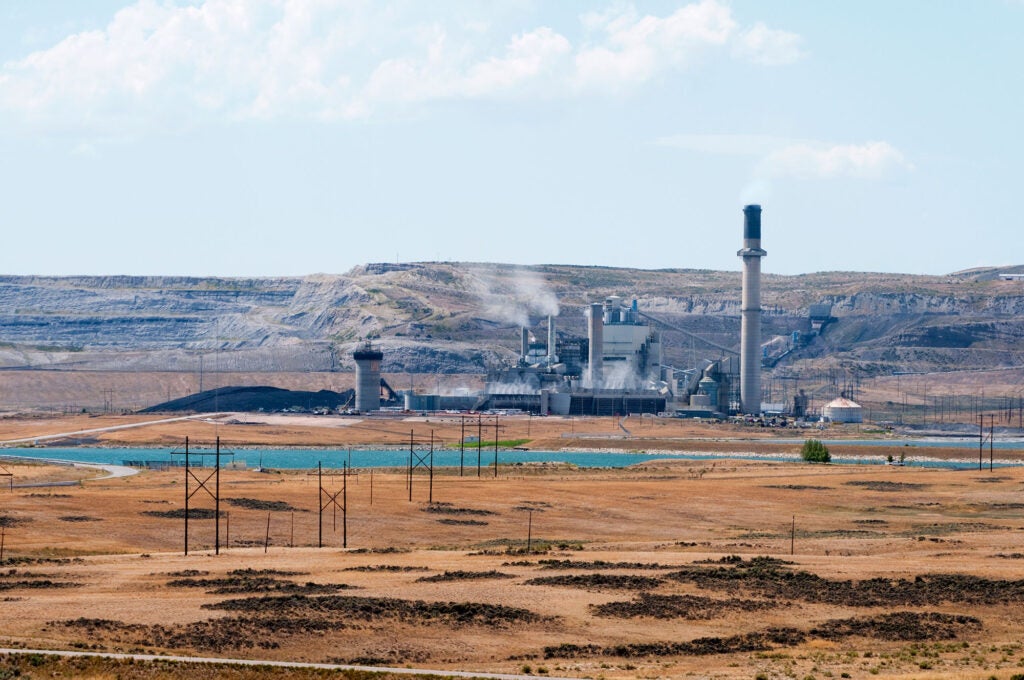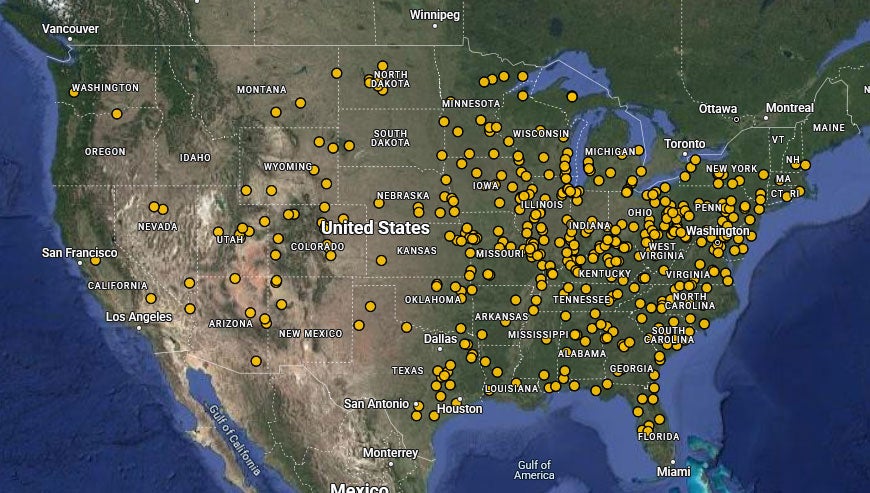October 1, 2025
Toxic Coal Ash in Wyoming: Addressing Coal Plants’ Hazardous Legacy
For many decades, utilities dumped billions of tons of coal ash — the toxic substance left after burning coal — in unlined ponds, landfills, and mines where the toxic pollution leaks into water and soil.
On this page
Across the U.S., immense coal ash dumps are leaking hazardous chemicals including arsenic, chromium, lead, lithium, radium, and other heavy metals, which have been linked to numerous types of cancer, heart and thyroid disease, respiratory illness, reproductive failure, and neurological harm. In addition to those well-known health threats, in 2023, the Environmental Protection Agency acknowledged that coal ash contains levels of arsenic and radiation that pose cancer risks.
Coal ash remains one of our nation’s largest toxic industrial waste streams. U.S. coal plants continue to produce approximately 70 million tons every year. Coal ash is disproportionately located in low-income communities and communities of color.
Industry’s own data indicate that across the country almost all coal plants are polluting water above federal safe drinking water standards.
Despite regulations established a decade ago, the coal industry has failed to comply with federal safeguards and uses deceptive tactics to avoid cleaning up its coal ash.
Because of industry’s widespread violations of coal ash regulations, in 2023, the EPA ramped up enforcement after designating coal ash a national enforcement priority. The EPA reports that many plants are illegally closing coal ash ponds with toxic ash sitting in groundwater, threatening drinking water and the health of nearby residents.
The longer industry delays, the more toxic waste enters our water, and the more difficult cleanup becomes. But the coal industry is asking Trump’s EPA to let them off the hook.

Action Needed
Federal coal ash protections established in 2015 and 2024 require monitoring, closure, and cleanup of the more than 1,000 coal ash dumps across the country. Cleaning up coal ash now will not only prevent another billion-dollar catastrophic failure, it will preserve drinking water; protect rivers, streams, and lakes; and allow safe redevelopment of power plant sites.
The magnitude of harm from recklessly dumped toxic coal ash requires decisive action from federal and state regulators:
- Power companies must be required to comply with the law and immediately clean up their pollution, including removing any coal ash in contact with groundwater.
- When power companies retire coal plants, they must clean up their toxic mess and leave communities with sites that benefit rather than harm their health, environment, and economy.
- EPA and states must prohibit the use of coal ash as a substitute for clean soil in construction (known as structural fill), especially in residential areas, and ensure cleanup of areas where ash was used as fill.
Click on plant locations on the map to see industry reports
Coal Ash in Wyoming
| Dave Johnston | PacifiCorp Energy | 2 pond(s), 1 landfill(s), and 6 potential ash dump(s) | 6 potential ash dump(s) | 4,959,901 | Arsenic (x1), Boron (x4), Cadmium (x2), Cobalt (x3), Lead (x2), Lithium (x1), Molybdenum (x10), Sulfate (x2) | WY-01 (Harriet Hageman) |
| Jim Bridger | PacifiCorp Energy | 3 pond(s), 1 landfill(s), and 1 potential ash dump(s) | 1 potential ash dump(s) | 25,396,866 | Antimony (x1), Arsenic (x4), Boron (x9), Cadmium (x3), Cobalt (x92), Fluoride (x3), Lead (x4), Lithium (x164), Molybdenum (x10), Radium 226+228 (x2), Selenium (x85), Sulfate (x125), Thallium (x11) | WY-01 (Harriet Hageman) |
| Laramie River Station | Basin Electric Power Cooperative | 5 pond(s), 1 landfill(s) | None estimated | 12,037,964 | Boron (x2), Lithium (x3), Molybdenum (x5), Sulfate (x9) | WY-01 (Harriet Hageman) |
| Naughton | PacifiCorp Energy | 6 pond(s), and 1 potential ash dump(s) | 1 potential ash dump(s) | 8,385,630 | Antimony (x2), Arsenic (x10), Barium (x1), Beryllium (x2), Boron (x16), Cadmium (x2), Chromium (x3), Cobalt (x13), Lead (x16), Lithium (x242), Molybdenum (x3), Radium 226+228 (x1), Selenium (x150), Sulfate (x66), Thallium (x9) | WY-01 (Harriet Hageman) |
| Osage | City of Osage | 2 legacy pond(s), and 2 potential ash dump(s) | 2 legacy pond(s), and 2 potential ash dump(s) | No data yet | No groundwater data reported | WY-01 (Harriet Hageman) |
| Wyodak | PacifiCorp Energy | 1 possible inactive pond(s), and 1 potential ash dump(s) | 1 potential ash dump(s) | No data yet | No groundwater data reported | WY-01 (Harriet Hageman) |
* Total volume of coal ash reported as of 2024 for ponds and landfills regulated under the 2015 Coal Ash Rule, and as of 2024 for legacy ponds at power plants that retired before October 2015. This volume does not include any of the potential ash dumps that will begin reporting in 2026.
** Parentheticals indicate magnitude of exceedance above federal health-based guidelines for drinking water based on industry data and analysis described in the report, Poisonous Coverup. See summaries of EPA reports.
Massive quantities of toxic coal ash are stored at six power plant sites in Wyoming.
Most of these power plant sites include older coal ash dumps that industry is only now beginning to quantify and monitor.
Power plant owners must report on an estimated 13 older coal ash dumps in Wyoming for the first time, under the safeguards established by the 2024 Legacy Coal Ash Rule. Those ash dumps are in addition to three landfills and 16 coal ash ponds (7 of which do not have protective liners to prevent leaks of hazardous chemicals) that are covered by the 2015 Rule. Those 19 dumps alone contain more than 50 million cubic yards of toxic coal ash. That’s equivalent to a football field piled over four miles high with coal ash.
For all plants with data available, industry monitoring reveals groundwater contamination above federal safe standards.
The City of Osage failed to report on two legacy coal ash ponds at Osage, in possible violation of the 2024 Coal Ash Rule. The Wyodak plant is located on the site of a coal mine, which may exempt the ash dumps at the plant from federal regulation.
For More Information
Christine Santillana, Senior Legislative Counsel, Earthjustice, csantillana@earthjustice.org
Lisa Evans, Senior Counsel, Earthjustice, levans@earthjustice.org.
About the Map
- EPA’s first coal ash regulations, issued in 2015, covered only some coal ash dumps, exempting older ponds and landfills at current and former coal plant sites.
- In 2024, EPA extended federal monitoring and cleanup requirements to hundreds of previously excluded older coal ash landfills and ponds leaking toxic pollution into groundwater and surface water. Industry is now required to monitor those older dump sites, filing initial reports on so-called ‘legacy’ ponds at former coal plants in 2024.
- In 2026, industry will be required to report on additional dump sites at operating power plants that did not receive ash after Oct. 19, 2015. Groundwater monitoring requirements are not yet in effect for these newly regulated dumps, so the table below may lack specific information about the number of units and the extent of contamination at a particular site.
More on Coal Ash in Wyoming
Coal Ash in States, Territories, Regions
Puerto Rico (En Español)
Earthjustice fights in the courts for a long-term solution to the toxic menace of coal ash. And we act on behalf of dozens of clients and over 100 coalition partners to defeat legislative attempts to subvert federally enforceable safeguards of coal ash.
Earthjustice’s Clean Energy Program uses the power of the law and the strength of partnership to accelerate the transition to 100% clean energy.
